Facebook is indeed the king of social media, with over 2.7 billion active monthly users and growing. Advertising on Facebook means better reach to your target audience since many of them are probably using it. Many companies and small enterprises use the social media giant to gain more brand visibility and importantly, generate leads for conversion.
Measuring the effectiveness of your Facebook Ads helps you to determine whether you are attaining your marketing goals. The assessment of strength, weakness and the return on investment of specific campaigns gives you insights to adjust accordingly.
Many Facebook users view ads as a nuisance and block them especially when the advertisement was of poor quality and irrelevant to them. Hence, it is important to measure the amount of reach, relevance, and value your ad campaign has on Facebook users.
Businesses ought to know the key metrics for Facebook ads and how to use them for better business decisions. On the Facebook ads manager metrics can be overwhelmingly confusing.
Here are important Facebook ad metrics 2021 that every small business owner needs to understand.
Engagement
Refers to the reception your ad is receiving from the target audience. It entails comments, shares, CTR, saves, likes or reactions. Engagement serves as a true reflection of what people feel about your ad. For instance:
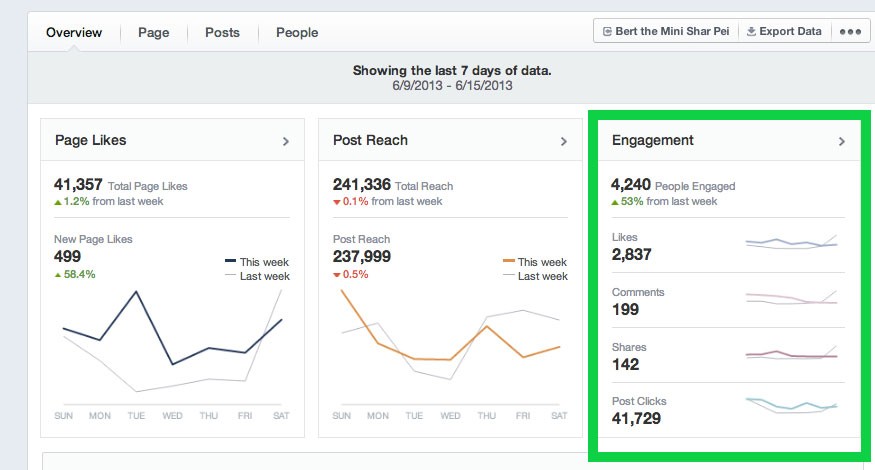
(Image Credit: 3Rhino Media)
High engagement rate implies that your content is interesting to its audience. An appealing ad helps to raise the overall awareness of your brand. The more people engage with your ad, the higher the likelihood of visiting your website, thereby improving your website traffic and SEO ranking.
The Facebook system usually uses the engagement rating to display your content on the news feed of users. Your ad’s high engagement rate will mean that Facebook will share the content with a larger group of your followers.
Low-quality ads result in low engagement rating, thus lesser attainment of your campaign objectives. The Facebook ad manager allows you to check the engagement rate based on specific measures such as video, photos, status or link posts.
Reach
The metric is arguably the essential Facebook ad metrics 2021 business owners should closely monitor. Reach refers to the number of different people who have seen your ad at least once.
Reach creates awareness of your ad campaign. In simple terms, we can say that reach is the maximum number of people that have seen your Facebook ad. For example:

(Image Credit: Hongkiat)
Reach of your campaign can occur in three main ways, organic, paid, or viral.
You Might Also Like
- Organic reach means that people saw your ad or content for free. However, due to Facebook’s commercialization of Ads, small businesses cannot rely upon this where brand awareness is at stake.
- Paid reach entails paying a fee on Facebook to promote your brand or campaign. It is the most reliable form of reach for small businesses and startups. It is more likely that your business can gain many views of your ads through this method alone.
- Viral reach for ads refers to the number of people who view the ads because their friends engaged in them by clicking, sharing, commenting, or posting them.
Analysis and monitoring of reach data statistics provide insights on the preferred content that palpitates with your target audience. Reach metrics forms the benchmark for analysis of all other metrics. It is futile to check the performance of your campaign if it has not reached anyone.
Test your website’s SEO and social media score in 60 seconds!
Diib is one of the best SEO and social media monitoring tools in the world. Diib syncs to Facebook and Google Analytics and uses the power of big data to help you quickly and easily increase your social media traffic and SEO rankings.
- Easy-to-use automated social media + SEO tool
- Keyword and backlink monitoring + ideas
- Speed, security, + Core Vitals tracking
- Automated ideas to improve Social Media traffic + sales
- Over 500,000 global members
- Built-in benchmarking and competitor analysis
Used by over 500k companies and organizations:
Syncs with 
Impressions
Impressions are often confused with reach. Whereas reach is the measure of people who have seen your campaign, an impression is a measure of how often they have seen the ads.
To understand this better, let’s say that 200 people have seen your ad. It means that your ad’s reach is 200. Say the same ad has appeared on the timelines of those 200 people for a total of 70 times. The impression for that ad is 70. The impression and reach do not show any engagements of the users with an ad campaign.
The cumulative total of the count an ad appears on the screen of an individual user during its lifespan is the count of impressions. There are two kinds of impressions on Facebook, served and viewed.
A served impressions mean that the advertiser has paid to promote the ad. The Facebook algorithm usually places these kinds of ads at the top of the users’ news feed. Facebook ad metrics explain viewed impressions as metrics that are not tallied unless a user sees the ad displayed on the screen.
Businesses should track these ad metrics to negotiate for fair pricing, promote consistency across mobile and web interfaces and get more value for their ads.
Demographics
Demographic refers to the number of people living in an area, their income, spending patterns, gender, age, race and ethnicity. In marketing, these statistics are useful in assessing the success of a campaign and a business. Through demographics, a marketer can know the target market, which product to sell, and how to advertise the products or services successfully.
The amount spent on planning a campaign plays a crucial role in determining success. The result should be proportional to the amount of effort and money put in a campaign.
Demographics help you to make decisions on how much investment to place in an ad strategy campaign. There are several ways of collecting demographic statistics. The most common is the use of customer orders and accounts. When customers sign up for shopping accounts or make payments, they fill in the details that lead to their preferences, age and spending habits. For example:
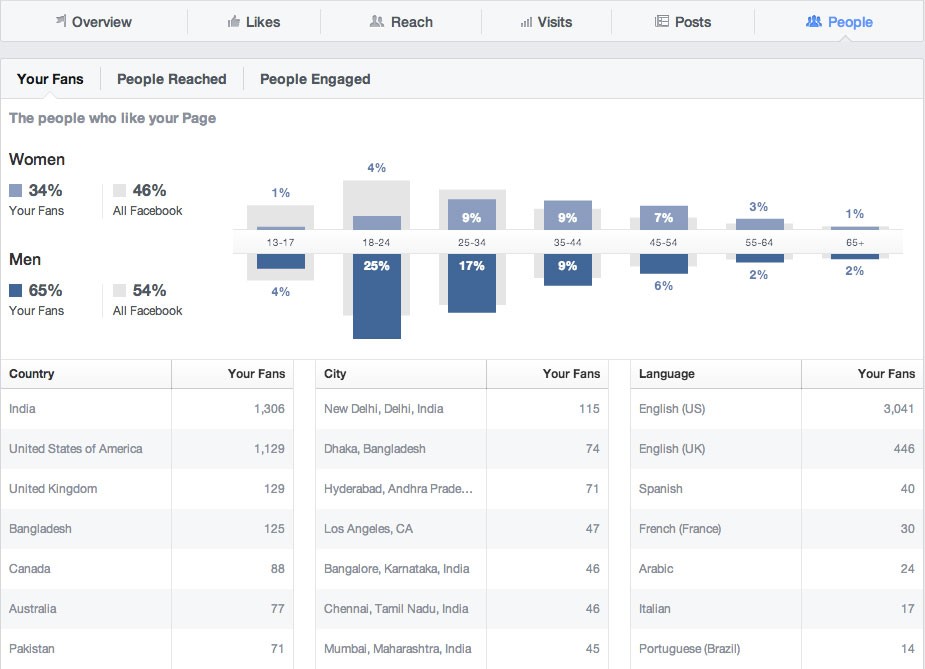
(Image Credit: Neil Patel)
Conversion Rate
The whole idea of doing an advert as a social media marketing technique is to convert. Even with excellent Facebook KPIs without conversions, the ROI will always be nil. A conversion refers to a successful response to the call-to-action. Conversion may entail a purchase, new subscription, or a click to the landing pages. In a nutshell, a conversion is a positive response to what you want Facebook users to do.
The conversion rate is a measure of the percentage of people who complete the desired action. It may include the total number of viewers of your advertisement, the number of people who become customers or subscribers of your email listing, and determine your conversion rate.
If, say, 1000 people viewed your Facebook ad, and your conversion rate is 15%. It implies that the advertisement will generate 150 conversions. These statistics are important so that you can understand how to optimize your ads for better conversions.
Cost per Conversion
Facebook ad metrics explained the cost per conversion as the amount you pay for every lead or sale. The total cost of running your ad campaign versus the number of conversions it attracts is your cost per conversion. For instance:
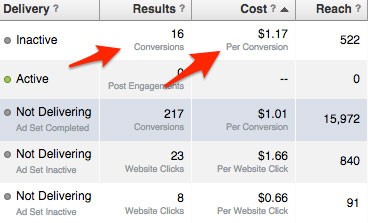
(Image Credit: Claire Pelletreau)
Putting it into perspective, say that you have spent $400 on your Facebook ads. If ten people convert, it means that your cost per conversion is $40.
The cost per conversion helps small business owners to assess if there is a positive return on investment. When the ROI is negative, it implies that the advertisement needs optimization.
Suppose your cost per conversion is high; you need to check on several factors. These include:
- Activate Facebook ads: Check whether you mistakenly paused an ad campaign.
- Impressions: Check to see which ad is underperforming and turn it off.
- Clicks: Check whether the ads are generating clicks. If the CPC is low, it is an indicator of more lots of interest in your advert.
- Landing pages: If all the above factors are okay, but you have a high conversion cost, it means that your landing page has issues and needs optimization.
CPM
CPM denotes the cost per thousand impressions. The word impression refers to the number of times Facebook displays your ad. CPM Facebook Ad metrics 2021 is vital if your major concern is how many times your advert will be displayed on Facebook.
The CPM helps small businesses to plan every new stage of their marketing campaign. You can also be able to approximate the results of past advertisements. The calculation of CPM is an average of the amount spent for advertisement divided by the total number of impressions, multiplied by a thousand.
For example, if your budget is $500 and you get 10000 ad views, your CPM will be calculated as follows:
CPM = ($500 / 10000) * 1000
CPM = $50
It, therefore, suggests that it cost you $50 to get a thousand advertisement displays.
The CPM and clicks are interrelated in that if you get more impressions with reduced clicks, you may be forced to pay a higher price.
To track your CPM on Facebook:
- Log into your Facebook ads manager and open the ads tab.
- Select the duration you want for the impressions.
- Click on columns.
- The Facebook Ads manager metrics will appear in a drop-down list.
- Scroll performance and clicks, then choose CPM (Cost per 1000 Impressions).
The Click-Through Rate (CTR)
The CTR is a percentage of Facebook users who visit your landing pages, data capture forms, website, or online storefront from your Facebook campaigns. In other words, CTR is a ratio of the number of links clicked on the number of ad views. Here is an example of a few click- through rates:
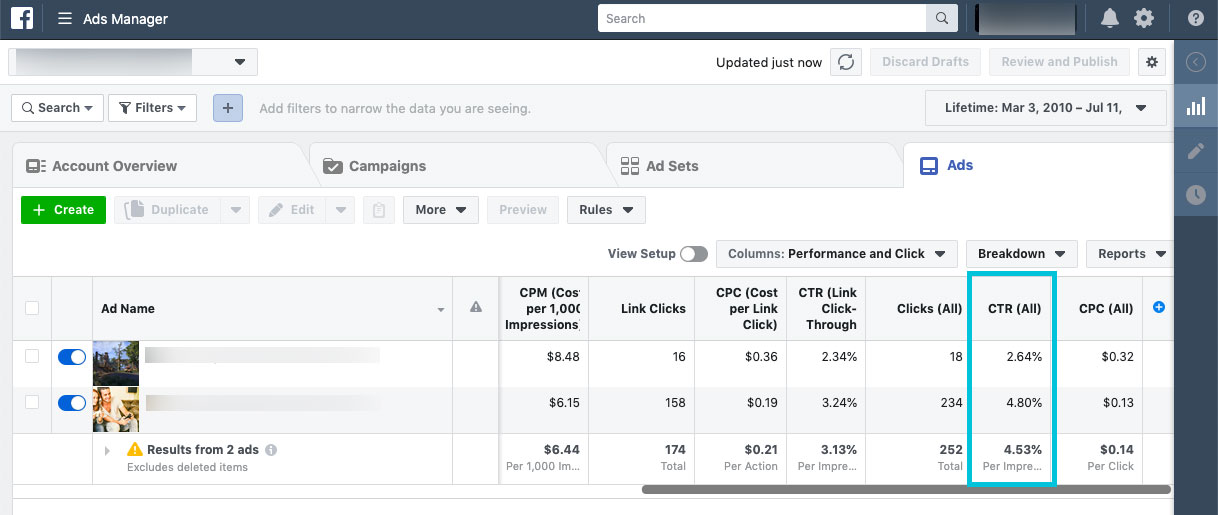
(Image Credit: Databox)
The good CTR is an indicator of a quality advert with high relevance and engagement. Conversely, a bad CTR, shows that the ad does not resonate with your target audience. Small businesses that aim at driving traffic to their websites or a recently launched product, should check the CTR Facebook Ad metrics.
Some advertisements may have higher CTR in contrast to others. Photos and videos, for instance, may have a higher CTR compared to articles. High-quality images and videos are likely to produce higher CTR than those of lower quality.
When using links for landing pages, it is imperative to note that a shortened link has a higher CTR. Otherwise, using long URL tags can be a turn off to potential visitors of your site.
To calculate the CTR, we use the formula below.
CTR= Link Clicks / Impressions
A higher CPM may result in a higher CTR, and the reverse is true.
Entrepreneurs should use this metric for better comprehension of their ad quality. Changes in graphics, headlines and wording in the call to action can significantly improve the CTR.
We hope that you found this article useful.
If you want to know more interesting about your site health, get personal recommendations and alerts, scan your website by Diib. It only takes 60 seconds.
Cost per Action (CPA)
The CPA, also called cost per acquisition, determines the amount of money you pay whenever Facebook users act your advertisement.
The actions could vary and may include:
- Watching a video.
- Clicking on a link.
- Signing up for a newsletter or email listing.
- Installing a mobile application.
- Generating a lead.
- Purchasing a product or service.
A high Cost Per Action shows that your campaign is not achieving its purpose. A low CPA, on the other hand, is a signal that your campaign is doing well.
Calculating CPA depends on the desired action performed on the ad.
CPA = cost of advertisement / Amount of action taken on the Ad
You can also calculate the CPA by dividing the advertisement’s cost against the product of conversion rate, click-through rate, and the number of impressions.
CPA = Cost of Advertisement / (CR * CTR * number of impressions)
Suppose it costs you $500 to get 10000 views, with 100 clicks and ten conversions. Calculate the CPA as follows
CPA = 500/10
CPA= $50
Alternatively, find the conversion rate and the click-through rate.
CR= (10 / 100) * 100
CR = 10%
CTR = (100 / 10000) * 100
CTR =1%
Your CPA is thus
CPA=500/ (0.1* 0.01* 10000)
CPA = $50
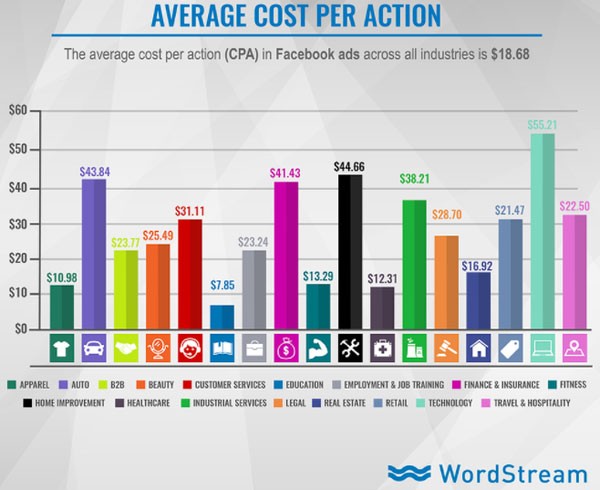
(Image Credit: WordStream)
CPC
The cost per click (CPC) is the amount of money you pay for an advertisement for the total number of clicks you get. CPC aims to evaluate the number of users who visit their website or landing pages through Facebook Ads.
The CPC may vary depending on the type of industry, objective, location, the season of the year, ad budget, bidding, and target audience.
The financial and insurance industries have relatively higher CPC compared to other industries such as apparel. However, the Facebook algorithm reduces your CPC if your click links get many clicks. On average, the CPC is $1.86 across all industries on Facebook.
CPC is calculated as the total cost divided by the number of clicks.
For example, if it cost $3 to get five clicks, the CPC would be computed as:
CPC =3/5
CPC= $0.6
The CPC in small businesses is one of the key metrics for Facebook Ads. For instance:

(Image Credit: 9 Clouds)
Frequency
Another ad metric you should watch out for is the frequency. It refers to the number of times a given user is exposed to the same advertisement before its lifetime expires. Suppose a user has seen your ad ten times it means that you have targeted him or her ten times. The frequency is bound to increase with a high budget.
The number of times a Facebook user sees your ad can result in your campaign’s success or failure. A high frequency would mean that the users have seen your advert and may be interested in your products or services. On the flip side, a high frequency may also be irritating your target audience, leading to banner blindness.
Banner blindness is when your ad becomes annoying and has an endearing experience to you and our audience. At this point, the users are fed up with your ad and will quickly bypass it. A low CTR on your campaign is likely to increase your CPA and CPC expenditure.
The frequency of your campaign is a ratio of the ad impressions against the reach of unique users. For instance, if an advert has reached 15000 people with 20000 impressions, then the frequency is computed as:
Frequency = Number of impressions/ Number of different people reached
Thus
Frequency = 20000 / 15000
Frequency = 1.33
The first time may have a relatively higher CTR, which in turn reduces the CPC. However, it is essential to understand that your ad’s high frequency may not improve your ROI.
Relevance Score
Relevance score refers to how engaging your ads are and their quality level. The score ranges from 1-10, and it determines how often your ads appear and the cost per click of your ads.
The score is determined by calculating positive and negative feedback. A higher the positive feedback is, the higher the relevance score. The score is generated as people continue to give feedback.
The relevance score can save on the cost of reaching out to people. The ad delivery system is built to only make the right content to the right people. As such, a high score saves on cost as it is delivered to the target audience.
A high score helps advertisers and marketers to ensure that the delivery is efficient. It also weighs the creative options for advertising before the marketers can launch a campaign. Through the score, advertisers can analyze images, audience and determine which combinations can secure high scores.
Finally, the scores can be useful when optimizing campaigns that are already in progress. The drop or rise in a score helps the advertisers to improve on the strategies.
Diib®: Understanding Your Facebook Ad Metrics
Now that you better understand the metrics involved in the conversion of your ads and how well they are received, you need to quickly respond to those metrics and optimize your ads. Partnering with Diib Digital will give you an added measure of security that your ads are reaching the audiences you seek and that they are converting well. Here are some of the features of our User Dashboard you’re sure to love:
- Social media integration and performance
- Platform specific audience demographics
- Keyword, backlink, and indexing monitoring and tracking tools
- User experience and mobile speed optimization
- Technical SEO monitoring
Call today at 800-303-3510 to speak with one of our Professional Growth Experts or click here for your free 60 second site scan.



